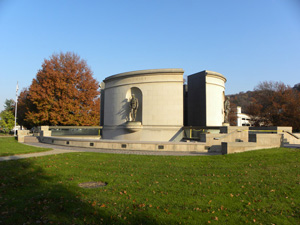

Remember...
Edward Earl Beckner
1926-1945
"Pearl Harbor caused our Nation to wholeheartedly commit to winning World War II, changing the course of our Nation's history and the world's future."
Joe Baca
 |
Remember...Edward Earl Beckner
|
Edward Earl Beckner was born on April 26, 1926, in Blaine, Ohio, to James Washington Beckner and Ruth Beckner. The 1930 Federal Census records that the family was living in Cabin Creek, Kanawha County, West Virginia. Mr. Beckner was a coal miner, and the family included children Patrick, Lottie, James, Andrew, Hazel, and Edward. In 1940, the family still lived in Kanawha County and was joined by Kenneth and Gardner.
Edward Earl Beckner registered for military service on April 21, 1944, in Kanawha County. He had been working at the local A&P. No record was found that indicates when Edward was inducted into military service, but his location is next found in public records in Bremerton, Washington, in January 1945. His rank was seaman second class (S2C), and the muster rolls of the USS Bunker Hill show that he was about to begin service as a sailor.
There were two U.S. Navy ships called the Bunker Hill. The first one is the one on which Edward Beckner sailed. It was an aircraft carrier built in Massachusetts and launched on December 7, 1942. It traveled to Virginia to pick up the planes, crew, and provisions of Carrier Air Group 17 from Norfolk, Virginia. After shake-down and training, the carrier left to join the Pacific Fleet in September 1943 and joined the war as part of a group of ships in November 1943.
From the Bunker Hill and the ships in the same group were launched many successful campaigns and raids against the Japanese, who sought to take the ships and their planes out of commission. The USS Independence was targeted with bombs that killed 17 sailors and wounded 43, causing the ship to be retired from battle. The Bunker Hill continued on until December, when the crew and ship had a break. The ship and crew continued their work throughout the spring of 1944 in much the same way, with increasing confidence and ferocity, racking up an impressive list of attacks on Japanese planes, ships, and land-based installations until the ship sailed to Pearl Harbor for repairs and maintenance. During this time at dock, CVG -17 was replaced by CVG-8 and the carrier attained a new set of capabilities. By the end of April, 157 Japanese aircraft were destroyed and "wreaked havoc" on ships, including sinking a destroyer, an aircraft transport, and list of submarine chasers. (Mark L. Evans and Guy J. Nasuti, "Bunker Hill I [CV-17]," Naval History and Heritage Command, 25 March 2020, accessed 22 July 2020, https://www.history.navy.mil/research/histories/ship-histories/danfs/b/bunker-hill-i.html.)
The Bunker Hill moved on to the Battle of the Philippine Sea in June 1944, participating in the actions to liberate the Marianas. According to Evans and Nasuti, the Bunker Hill continued to "exact a heavy toll on the Japanese in the month of September 1944," and the service record of ship and crew only improved through the fall. The ship returned to the U.S. to the Bremerton, Washington, dock for maintenance and repairs as well as a crew refresh. CVG-84 joined the squadron.
When Edward Beckner joined the Bunker Hill crew in January 1945, he joined an experienced and successful group. He left with the ship from Bremerton, Washington, in January 1945 to Alameda, California, then to Pearl Harbor, and then back to battlegrounds of the western Pacific. The Bunker Hill was among the ships off-shore during the Iwo Jima landings and then supported actions on Tokyo, Kyushu, and Okinawa over a period of 58 days.
Edward Beckner appears in the ship's muster rolls in January, March, and May as S2C Edward Beckner. He was transferred to the ship on January 10, 1945, from Shoemaker, a reference to a training facility in Dublin, California, during World War II. He was also shown to be present in March and May.
The May muster roll of the Bunker Hill tells the terrible tale, with many personnel listed as killed and buried at sea, missing, or injured and transferred to another ship. At the time the May muster roll was taken, the ship was noted to have traveled from a restricted area to a censored area, and Edward Beckner was listed as missing. He later appeared on lists of the war's dead. No record was found that explains where Edward Beckner was on the ship when the attacks occurred.
Despite heavy damage, the ship's crew worked tirelessly to defend the ship from continued kamikaze threats and fire as well as care for the injured. Many acts of heroism were noted of those who stayed at their stations despite immediate potential of death to keep the ship running or defend it. Nearby ships rushed to assist, rescuing several men from the water or receiving injured sailors. Due to their valiant efforts, the ship did not sink and proceeded under its own power back to Pearl Harbor and then on to Bremerton, where it was still undergoing repairs when the war ended. By September 1945, the seemingly indestructible ship was back in service as part of the fleet that transported servicemen back to the U.S. from the Pacific Theater. ("USS Bunker Hill [CV-17]," Wikipedia, last edited 29 October 2020, accessed 20 November 2020, https://en.wikipedia.org/wiki/USS_Bunker_Hill_(CV-17).)
Article prepared by Cynthia Mullens
November 2020

West Virginia Archives and History welcomes any additional information that can be provided about these veterans, including photographs, family names, letters and other relevant personal history.